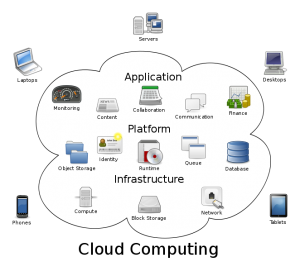Cloud computing – The infrastructure challenge in Kenya
Clouds outside my window have been gathering and darkening for the last few minutes and within no time now they will open up and unleash the downpour on us. What’s drifting my thoughts into the clouds to test my weather forecasting skills is the slow loading speed of an internet page I clicked earlier. This is as a result of a technical problem with two of the main undersea fibre optic cables – EASSy and Teams. This problem started four days ago and the technical teams resolving the issue say the problem may persist for a week or two.
This observation of the clouds also brings to mind, a launch I had earlier attended on cloud computing by one of the major telecommunications companies in Kenya. At this forum, bright future promises of cloud computing were brought forth and pertinent concerns were raised by the audience as well. It makes me ponder at what are the main infrastructure challenges that are going to face business in this region as they adopt cloud computing.
Wikipedia defines cloud computing as the delivery of computing as a service rather than a product, whereby shared resources, software, and information are provided to computers and other devices as a metered service over a network (typically the Internet).
The cloud computing company provides a data centre with servers in a remote location hosting business software and data. The end-users access the applications through a web browser or in light weight applications interfaces on their desktop or mobile devices and operate them just as if they were installed in their local devices. The pros touted for cloud to the users are rapid infrastructure deployment (such as servers, storage, and networking) during applications roll out and also to meet future demands, easy manageability, and less maintenance.
Cloud is now hosting some key business applications that were previously run locally and that according to an article on Forbes magazine, by Tien Tzuo, is slowly leading to the death of the Enterprise Resource Planning (ERPs). Whether this will be the case is a debate and a topic for another day. What is happening though is that, the major players in the ERP software application industry – Oracle and SAP, are trying to venture into cloud business through acquisitions of companies offering cloud services. There is the SAP’s pending $3.4B acquisition of SuccessFactors, and now Oracle’s $1.9 billion deal to buy Taleo.
This trend means that soon companies are going to deploy their key business applications to run on cloud. What does that mean for companies based in our African region especially the international ones whose technology push comes from the mother companies in developed countries?
One important key to success of cloud applications uptake by end-users, and for any other application platform, is availability. Availability of cloud services is largely dependent on reliable internet connection with good speeds, hence posing a major challenge for this region. The good thing though is that, there is great progress in internet availability in Kenya owing to the investment in undersea fibre optic cables. The country is now being served by three of them– Seacom, the East African Marine System (Teams) and East Africa Submarine Cable System (Eassy). France Telecom has also funded the fourth one – Lower Indian Ocean Network 2 (Lion2) which is undergoing tests and is going to be in operation soon. This is actually the main selling point by the cloud service providers in this region.
However, the infrastructure challenges such us the ongoing downtime in one of the backbones will continue to occur hence the need for them to be factored in the planning as companies adopt cloud computing. If a company is running key applications on cloud and relying on this link that is currently down as the only connection, then its business would have been heavily and negatively affected.
With cloud computing here to stay, companies that are going to implement and run key business applications on it, will also need to invest in risk analysis and planning so as to put in place measures like redundancies in order for them to ensure availability of their key services. The other selling point being touted by the local cloud providers is that customers adopting their services as opposed to those of international providers like Google, Amazon, Microsoft e.t.c. face less risks of availability since their data centres are local. However, with the now common occurrences of local underground cables being cut and even vandalized, the same infrastructure downtime risks exist hence still the need to do risk planning to ensure availability.
